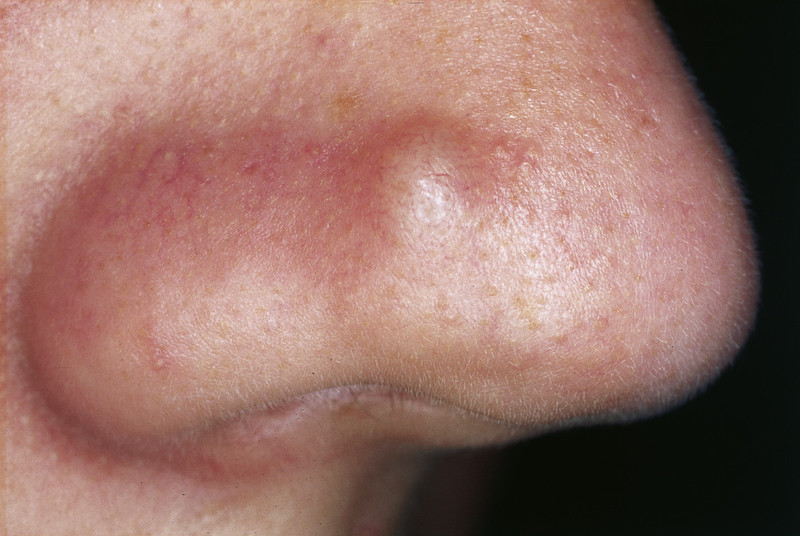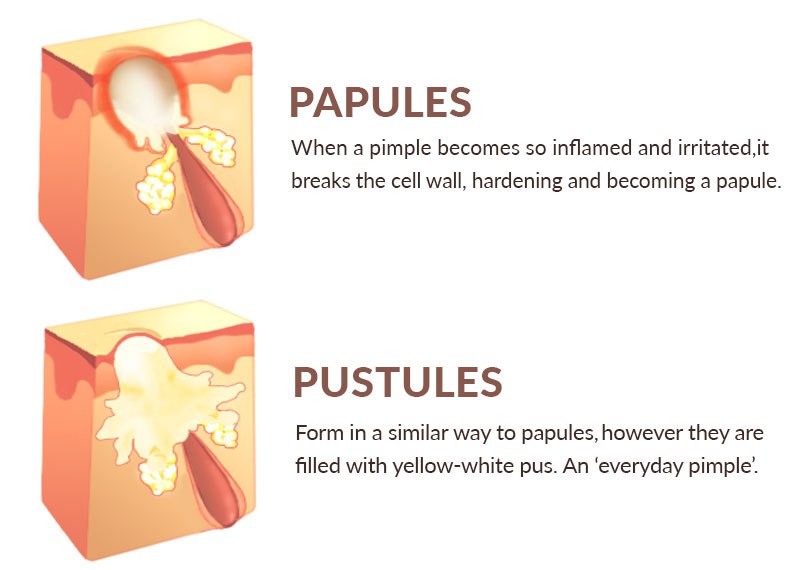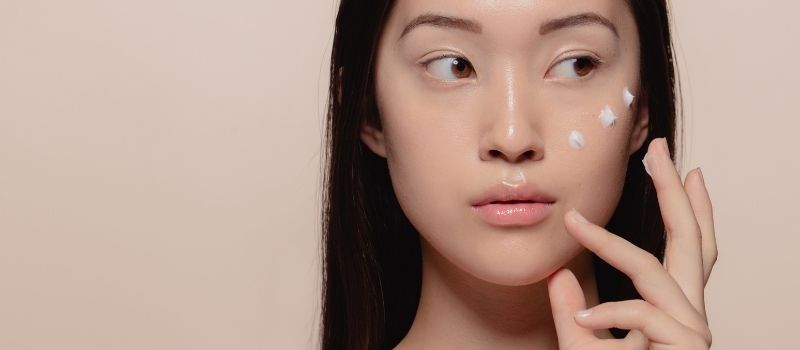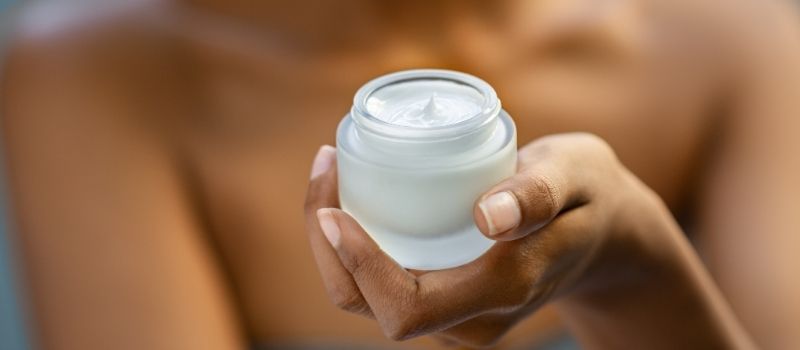Papules are a type of acne characterized by being slightly raised from the surrounding skin, often discolored or red, and most commonly roundish in shape.
Although very common, papules can be challenging to deal with and often cause pain and discomfort in the area where they appear.
However, there are ways to get rid of them, as well as steps that you can take to prevent them from coming back.
Therefore, in this article, I will explain everything you need to know about papules, what causes them, how to get rid of them, and how to banish them from your skin in the long run.
How to Get Rid of Papules (Key Takeaways)
- Exfoliate.
- Apply benzoyl peroxide.
- Incorporate retinoids into your routine.
- Apply a warm compress to relieve swelling.
What Is a Papule?
A papule is an inflamed skin lesion that’s hard to the touch and looks like a red bump on the skin.

When a papule forms, it often leads to discoloration in the area and appears slightly elevated from the surrounding skin.
It can also be painful to touch and feel deeply rooted within the skin.
Some people describe the sensation of pressing a papule as a headache, as the pressure can cause a dull, throbbing pain similar to that of a headache.
The depth at which the inflammation occurs within the skin can often cause this sensation, as deeper inflammation tends to result in more pain.
Papules are usually harmless, though if many are present in small areas, this may indicate a more serious health concern, such as hormonal imbalance.
What Is Inside a Papule?

A papule is a solid pimple caused by a clogged pore that becomes inflamed
Inside a papule, you’ll typically find:
- Sebum: Oil produced by sebaceous glands in the skin. When produced in normal amounts, sebum helps protect the skin from external pathogens and environmental aggressors. However, excessive sebum production can lead to clogged pores.
- Dead Skin Cells: Our skin is constantly shedding dead skin cells. However, sometimes, these cells don’t shed completely and can mix with sebum and form plugs that clog pores.
- Bacteria: Specifically, Cutibacterium acnes (C. acnes) bacteria, which live on our skin naturally. When trapped inside a clogged pore, these bacteria can multiply rapidly, leading to inflammation and the formation of a papule.
- White Blood Cells: These are part of the body’s immune response that fights against the overgrowth of bacteria through creating inflammation.
Ultimately, the major cause of papules is clogged pores.
When pores become clogged with sebum, dead skin cells, and bacteria, they become so filled that their walls break due to the pressure of the gunk inside them.
This rupture allows the cellular debris and bacteria to spill into the surrounding areas, triggering the immune system to send white blood cells to the area and fight against the spillage it considers a foreign body.
This ‘battle’ between the immune system’s white blood cells and the spilled cellular debris causes redness, pain, soreness, and inflammation, or the firm, red bump we call a papule.
RELATED: The Best Products To Unclog Pores
How to Get Rid of Papules?

Depending on the severity of a papule, you may be able to treat it at home or visit a doctor for medical treatment.
Here are the best ways to treat papules at home:
Exfoliation
Regular exfoliation can help dissolve dead skin cells and oil plugs and unclog pores to soothe inflammation and prevent bacterial overgrowth, which will help calm the skin and minimize the appearance of papules.
Best exfoliating products for papules contain ingredients such as:
- Salicylic Acid: An oil-soluble beta hydroxy acid that penetrates the pores and dissolves oil and dead skin cells stuck inside. This helps unclog pores and reduce the appearance of papules.
- Glycolic Acid: Glycolic acid is an alpha hydroxy acid that gently exfoliates the skin’s surface, helping to clear away dead skin cells and minimize the appearance of papules by shedding the surface layers of the bump away.
- Mandelic Acid: Mandelic acid is another type of alpha hydroxy acid with anti-inflammatory benefits and larger molecules, making it less irritating and suitable for sensitive skin experiencing papules.
Benzoyl Peroxide
Benzoyl peroxide is an effective treatment for papules due to its ability to infuse the pores with oxygen and destroy the airless environment the C. acnes bacteria need to survive.
In addition to its antibacterial action, benzoyl peroxide also acts as a peeling agent, which can both reduce the number of existing acne lesions and prevent new ones from forming.
Lastly, benzoyl peroxide has anti-inflammatory properties.
Therefore, since acne lesions, including papules, are often inflamed, reducing inflammation can help decrease the redness and swelling associated with papules.
RELATED: How Does Benzoyl Peroxide Work?
Retinoids
Retinoids are another fantastic topical medication commonly used to treat acne, including papules.
They have several mechanisms of action that can help reduce the appearance of papules, one of which is an increase in cellular turnover, which is the rate at which new skin cells are produced and old ones are shed.
This helps the dead skin cells move toward the skin’s surface instead of getting stuck inside the pores and causing them to become clogged.
Secondly, retinoids have anti-inflammatory properties.
Acne, including papules, often involves inflammation; therefore, by reducing inflammation, retinoids can help relieve the redness and swelling associated with these lesions.
Finally, retinoids can also regulate sebum production by normalizing the skin’s function.
When the skin functions optimally, it’s capable of retaining hydration; therefore, it won’t need to overproduce pore-clogging oil to compensate for a lack of moisture.
This reduces the likelihood of papule formation and other types of acne lesions.
However, while beneficial for acne-prone skin, it’s important to note that retinoids can cause initial side effects, such as dryness, peeling, and irritation, during the acclimation period.
These side effects usually improve with continued use.
RELATED: How To Fix Retinol Damage?
Warm Compress
A warm compress can be another useful way to calm acne papules at home.
The heat from a warm compress can help soften the skin and the pores, which can aid in draining any trapped sebum or dead skin cells that may be causing the papule.
Additionally, the warmth can also help reduce swelling and make the papule less noticeable.
How to Prevent Papules?

Papules are usually caused by excess oil and dead skin cells that get trapped inside the pores and attract bacteria.
Therefore, keeping the skin clean and using the right products for your skin type can reduce these types of breakouts, prevent papules from developing, and maintain your skin smooth and well-hydrated.
Here are some daily habits you can incorporate into your routine to prevent papules from showing up:
Cleanse Regularly
Throughout the day and night, excess oils, dirt, and impurities can build up on the surface of your skin and clog your pores, which we already know will inevitably lead to unwanted breakouts, including papules.
Therefore, you have to make sure you remove these impurities by diligently cleansing your skin once or twice a day with a gentle cleanser.
This will prevent the buildup of pore-clogging debris and help get rid of existing papules while preventing new papules from forming down the line.
Incorporate Acne-Fighting Ingredients
Consider incorporating products containing benzoyl peroxide, exfoliating acids, or retinoids into your skincare routine, as these ingredients will help clear existing acne and prevent new blemishes from forming.
Avoid Scrubbing
Don’t scrub your skin during cleansing or by using harsh scrubs and towels to dry it, as this can cause irritation and may even cause the lesion to rupture and create a wound that’s susceptible to infections and scarring.
RELATED: Should I Exfoliate When I Have Acne?
Minimize Makeup
While covering up your papules with makeup may seem like the only way to feel confident about your skin, this could potentially make the problem worse.
Heavy makeup, especially high-coverage foundations, and concealers, often contains comedogenic ingredients, which can clog pores and lead to more breakouts down the line.
Therefore, it’s best to avoid wearing makeup to give your skin a chance to heal from clogging and inflammation.
However, if you absolutely must wear it, try opting for tinted moisturizers or mineral foundations that blur imperfections without harming your skin and exacerbating acne.
RELATED: Can Makeup Cause Acne Breakouts?
Avoid Touching Your Face
Touching your face isn’t an easy thing to just stop doing.
However, by constantly touching your face, you keep piling bacteria, germs, and impurities that have accumulated on your fingertips throughout the day directly onto your already vulnerable skin.
This translates to inevitable skin problems in the long run; therefore, try to become more aware of this habit and consciously work on reducing it.
Here are some strategies to help you avoid touching your face and prevent papules down the line:
- Keep Your Hands Busy: If your hands are occupied with a task or an object, they’re less likely to gravitate toward your face. Consider keeping a stress ball or small toy at your desk to keep your hands busy.
- Practice Good Hand Hygiene: Regularly washing your hands can reduce the amount of bacteria and germs that could potentially be transferred to your face.
- Use Tools for Application: If you find yourself touching your face often due to a skincare or makeup routine, consider investing in brushes or sponges to apply products instead.
RELATED: 10 Hygiene Tips To Prevent Acne
Can You Pop a Papule?
Papules are a type of acne that appears as small, red bumps on the skin.
Unlike pustules, which are filled with pus, papules are not filled with any substance that can be “popped” or squeezed out.
Instead, they are solid, inflamed lesions that occur when oil and dead skin cells block the skin’s pores, leading to bacterial growth and inflammation.
When you attempt to pop a papule, you’re likely to cause more harm than good, as since there’s nothing inside that can be expelled, the pressure from squeezing can tear the skin.
This not only increases the risk of introducing more bacteria into the area and risking an infection, but it can also lead to loss of tissue and scarring.
On the other hand, allowing a papule to heal on its own is typically the best course of action.
The body’s immune system will naturally work to clear the inflammation and bacteria over time.
This process is less likely to result in scarring, especially if you avoid touching or irritating the papule.
Keep in mind that treating acne often involves addressing the underlying causes, such as excess oil production, bacteria, and dead skin cells, rather than simply managing individual blemishes.
Over-the-counter treatments or prescription medications may be beneficial, depending on the severity of your acne.
Frequently Asked Questions
What’s The Difference Between Papule and Pustule?
A papule is a small, solid, and typically red inflammation of the skin that does not contain pus.
On the other hand, a pustule is also a small, round lesion of the skin like a papule, but it’s filled with pus, giving it a white or yellowish center surrounded by a red halo.
A pustule is considered a matured papule as it has progressed and now contains a collection of pus.
By this, we can conclude that if our immune system doesn’t clear up the accumulation of cellular debris inside the pores, a papule can become an infected pustule.
What’s The Difference Between Papule and Nodule?
A papule refers to a small, raised, and typically solid pimple on the skin that does not contain pus.
On the other hand, a nodule is a larger, solid lesion that extends into deeper layers of the skin, often causing pain.
Do Papules Go Away on Their Own?
Papules usually go away on their own within a week, but they can become inflamed and turn into pustules.
This can prolong the healing process and increase the risk of scarring.
How Long Does a Papule Last?
A papule typically resolves itself within 48 hours to a week, though this can vary depending on the individual and the specific conditions.
Applying topical treatments like benzoyl peroxide can expedite this healing process.
How to Get Rid of Papules Overnight?
While this type of acne usually heals on its own within a few days to a week, a papule injection technique may help get rid of papules overnight if waiting it out is not an option.
The papule injection technique is a method used by dermatologists to quickly and safely get rid of papules and involves injecting a controlled amount of corticosteroid directly into the papule, which reduces inflammation and promotes healing.
This procedure should only be done by a trained professional and can be painful, but the results are often worth it for those looking for quick relief from papules before an important event.

My name is Simone and I am a certified skin specialist. I created this website to teach my readers how to take great care of their skin and I also like to occasionally share my honest opinions on skincare products I’ve tried. You can learn more about me here.
